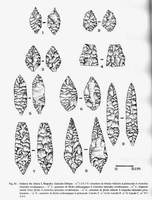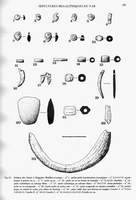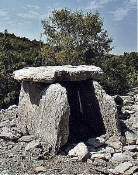The dolmen
On the limit line of crests between The Valley and Brignoles four dolmens were discovered and studied in the Adrets. The dolmen presented below is the best preserved dolmen and most easily " visitable "; it is the dolmen said " adrets I ".
This dolmen, as the others, was the object of systematic searches. The oldest layers of the one of them supplied bones and strings of pearls reminding the funeral destination of these monuments. The most recent layers supplied as for them the more modern pieces going from gallo-Roman ceramic to flints and currencies of 3rd French Republic.
| View of the dolmen through pine trees | West entrance and its alley | North entrance and Facade | The main facade is oriented to the north
|
Rehabilitation of the inside of the dolmen |
Click on a picture to enlarge it
Some details
The dolmen of adrets I in the history of megaliths:
This dolmen is situated on a hill dominating the Le Val Valley, at a height of 341m. This dolmen was raised on a tumulus of elliptic shape the current height of which is of the order of 60 cms for a big diameter of 10 m in the North-south axis and the small diameter of 8 m in the East-west axis.
The door of the Dolmen opens on the West and is preceded by a corridor.
The dolmen possesses a sepulchral chamber of oblong shape of about 2 m in the East-west axis and of 1,7 m in the North-south axis. The head which limits the chamber in the East is vertically planted and at an irregular height (1,9 m in the South and 0,85 m in the North) what leads the table of coverage the weight of which is estimated at 10 tons to have an oblique position, "opening" the dolmen to the North. Doubtless "recent" opening, the north low wall doubtless had to rise until the height of the table originally (?). The table of coverage rests in the South on the tumulus.
The door is blocked by a stone of threshold which opens between pillars of uneven sizes marrying the slope imposed by the stone of head. The table had doubtless been moved during an earth tremor; during the study of the Dolmen, one of the pillars was broken, the other one did not support practically any more the table of coverage; the current state results from a restoration.
The table of coverage was constituted from a raw paving stone resulting from Dolomitic layers close by.
The bottom of the sepulchral chamber had been paved.
Numerous vestiges of fineries were discovered during the searches, the pearls among which some in bauxite or soapstone, drops, fragments of bracelets. Points of arrows of various forms and varied finishes were also dug up.

Click on a picture to enlarge it |

Click on a picture to enlarge it |
Finally some fragments of ceramic and a " pencil of ochre " were also identified.
About fifteen kilos of human bones was dug up resulting from various layers identified during the searches. All these bones are very split up with visible tracks of cremation; they belong to children, adults and old men (children's teeth: 199 that is 16 %, of adults: 957 is 78 % and of old men: 65 that is 6 %).
The presence of these bones, witnesses of a funeral rite developed around the practice of the cremation, reminds the "sacred" usage of these dolmens and show the wealth of the social life of these men towards the age of Bronze. Age of the bronze which is also represented on the municipality by the Essartènes decorated shelter.
The dolmen of adrets I in the history of megaliths:
If we compare the Var with departments situated more on the West, we can only notice the number limited by megalithic graves; we indeed count 45 while more than 500 monuments were identified in the Lot, and while the Gard and the Hérault count several hundreds. The evaluations of datings either made on the basis of measures absolved in the Carbon 14 (little regrettably) or on the study of the furniture found during the searches lead to place these monument at about the period of transition between the final Neolithic and Chalcolithic Pré-Campaniforme, or enters the middle of the 3rd millennium and the beginning of 2nd; thus very posterior to the monuments of the current Celtic world. The custom of these grave seems to have gone out of use from the final Bronze age.
These observations lead to imagine a slow scattering of the megalithic culture by the West of France following the coast followed by a movement eastward.
We also think that these monuments were raised by populations which already had a metal industry of the copper. Although the region is taken away enough from the sources of ore, the weakness of the dug up brass vestiges would tend to make suppose a little dense populating and a certain material poverty.
Poverty material which does not exclude for all that a certain cultural wealth, the practices funeral suggested by the megalithic monuments, the collective graves but without depriving the individual of his personality (fineries, offerings) are there to demonstrate it. These monuments, beyond the ritual practices suggest a certain social organization, "monks", "leaders" and "artists / artisans". Cultural wealth proofs of which will also have we in the decorated shelter of the Essartenes.
Les sépultures mégalithiques du Var, par Odile Roudil et Georges Bérard, 1981, Centre national de la recherche scientifique, Centre régional de publications de Marseille.
A site very rich in megalithic monuments of Provence:

